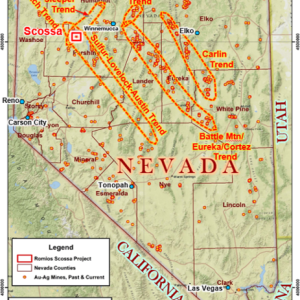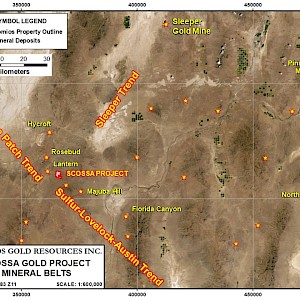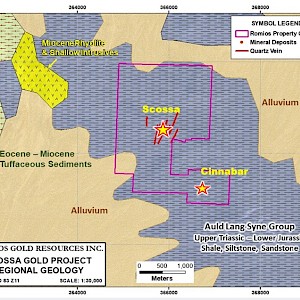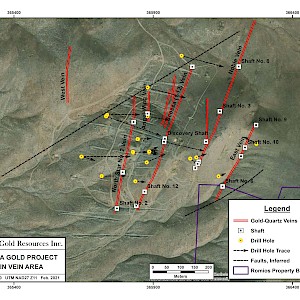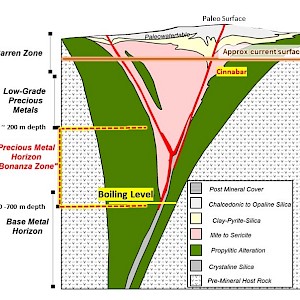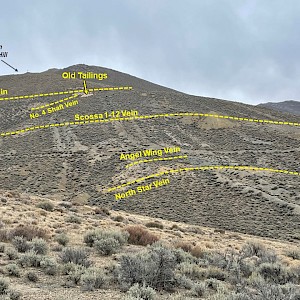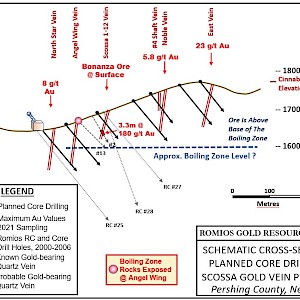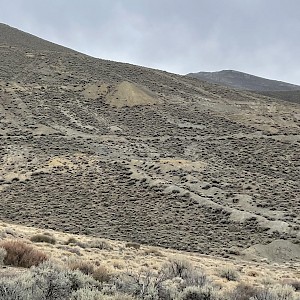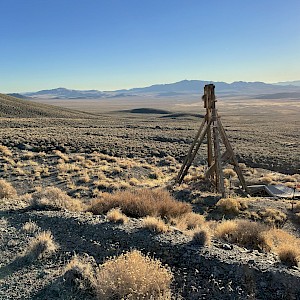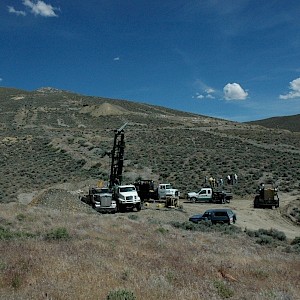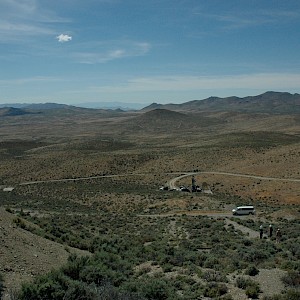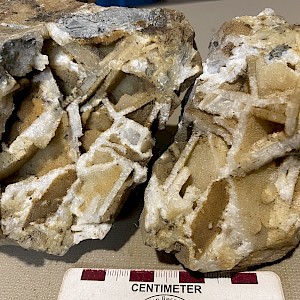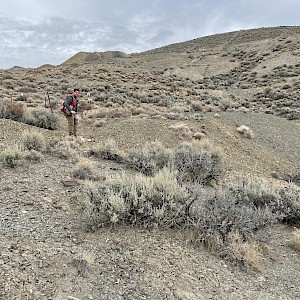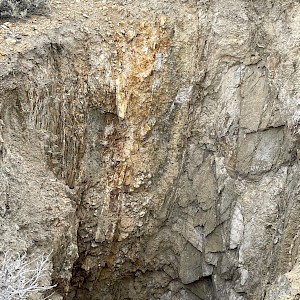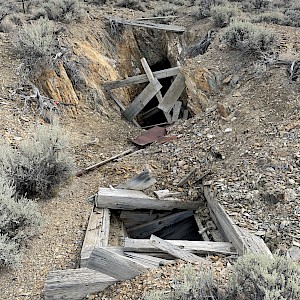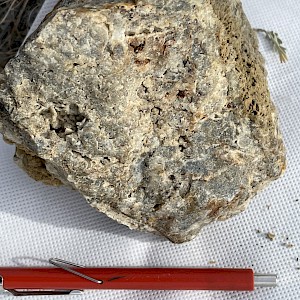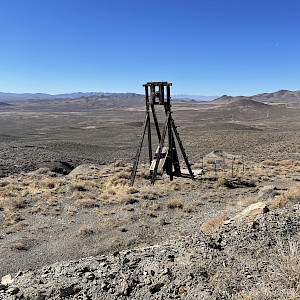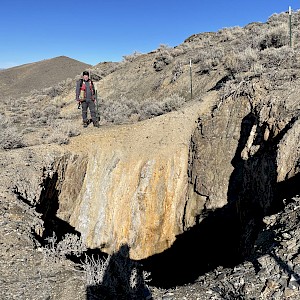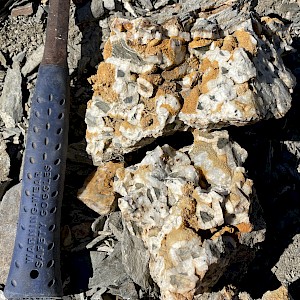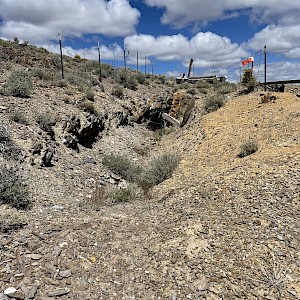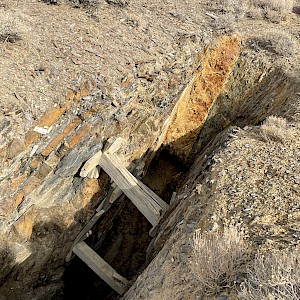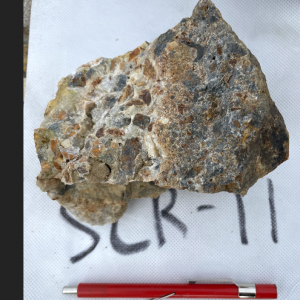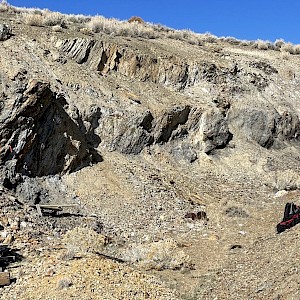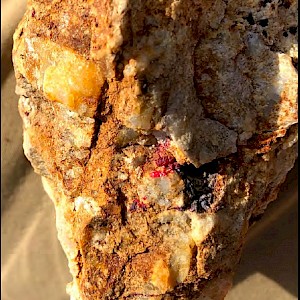Scossa Mine
-
Overview
Property Type- Epithermal vein system. Five major veins with smaller veins intervening locally.
- Boiling zone textures exposed at base of hill; sub-parallel set of veins extend uphill from there providing >150 m vertically of favourable veins.
Size- 541 Hectares / 1,337 Acres
Status- Combination of lode claims (covering the known veins) owned by Romios Gold Nevada Inc., a wholly owned subsidiary of Romios Gold Resources Inc, and subleased private lands acquired to cover potential extensions to the mineralized veins.
Exploration Stage
The Scossa property covers a former producing mine (1930’s to 1941) which mined high-grade gold ore from 5 epithermal veins down to a maximum depth of 400 ft.
The property was drilled in 2000, 2003 and 2006, intersecting Bonanza grades in one section of the main Scossa vein.Building on the past drill results, a recent 3D model of the vein system, and a revised geological model, Scossa is again at the drilling stage with a new focus on the down-plunge extension of the ore shoots previously mined at shallow levels.
Location
Located in Pershing County, northwestern Nevada, approximately 95 km southwest of Winnemucca. Accessible by road.
-
Geology/Exploration
Highlights Of Key Target Areas
• The Scossa vein system is a series of at least 5 low-sulphidation epithermal quartz veins with locally Bonanza-grade gold +/- silver mineralization mined from a series of shafts.
• Individual veins are up to 500 m long and are exposed in a sub-parallel series over a vertical extent of >10000 m up the side of a large hill.
• Boiling zone textures (boxwork or lattice “Angel Wing” calcite pseudomorphed by quartz) are exposed near the base of the hill and recent surface samples on the hilltop veins assayed up to 23 g/t Au and 84 g/t Ag, indicating that there is potential for at least 150 m vertically of mineralization above the base of the hill/exposed boiling zone, in addition to the unknown vertical extent of the boiling zone at depth.
• Recent 3D model highlights the plunge of the historic mined ore shoots into an area with little or no drill testing. Historic ore grades are believed to be > 1 oz/t Au.
• The recently staked “Cinnabar Showing”, 1.4 km from the Scossa veins system, is a highly altered fault zone containing cinnabar, a mercury sulphide mineral commonly found in the uppermost levels of epithermal Au-Ag veins. Gold-silver mineralization would typically be found at depth beneath the mercury level. This vein has apparently never been drill tested.
Scossa Mine Site Prospect
The Scossa gold deposit was discovered by the Scossa brothers in 1930 and development started soon after with the sinking of shafts and drifting laterally along the gold veins from several levels, of which the deepest level is approximately 122 m below the surface. During the period of 1930 to 1935, high-grade ore, reportedly average grade of 1.3 ounces of gold per ton, was mined but no records of the total production of gold are available. The mine closed in 1941 during WWII. Some of the ore was so spectacularly high grade that it was stored in a bank vault in Lovelock. After the mine closed there is little record of any work but there is a series of large overburden trenches excavated in the 1960s across the west face of the hill hosting the veins.
The mineralized veins trend NNE cutting phyllites, siltstone and arenites of the Triassic-Jurassic Auld Lang Syne Formation. These metasediments are intruded by a series of intermediate dykes with variable orientations, predominantly WNW. These dykes are often highly altered to clays and may locally be mineralized.
Romios acquired the Scossa property in 1999 and conducted a surface mapping and limited underground mapping program before commencing a 14 hole diamond drill program in 2000. This small diameter core drilling intersected Bonanza grade gold mineralization at shallow levels along the main Scossa I-12 vein, i.e. 180.2 g/t Au and 4 g/t Ag over 3.35 m in RGR-02, 268 g/t Au and 22 g/t Ag over 1.98 metres in RGR-03, and 62.5 g/t Au and 73.4 g/t Ag over 1.53 metres in RGR-05. Recoveries were hampered by the small size of the core and the locally broken up nature of the veins. Two subsequent RC drill campaigns in 2003 and 2006 largely targeted the veins at various depths, often ≥200 m below the base of the hill, with generally poor results. At least one hole targeted the vertical projection of the earlier Bonanza grade intercepts but results here were also poor. Based on the results of all the Romios drilling and the 3D model of the ore shoots recently completed, it would appear that the main ore shoot(s) on the I-12 vein plunges steeper to the south than expected and would have been missed by the past drill programs. Historic data of the workings on the other four mined veins is insufficient to determine the plunge of those shoots.
The Scossa veins have been mined to a maximum depth of 122 m on the main I-12 vein and shallower levels on the parallel veins. Experience at other epithermal vein mines in the district indicates that the mineralization often has a vertical extent of 183 to 366 metres. In a typical epithermal system, gold begins to precipitate at the boiling level of the ore-forming fluids rising up a fault zone, and extends upwards from there for 150 m to as much as 500 m in some regions. The boiling zone forms distinct vein textures and some of these are exposed at surface on the Angel Wing vein at the base of the hill hosting the Scossa mine. Spectacular lattice textured bladed calcite crystals replace by quartz indicate the boiling zone elevation was at the base of the hill. Gold mineralization can be expected to continue upward to the top of the hill (as indicated by high-grade assays at surface) and to some unknown depth within the boiling zone. Future drill programs will target the favourable vertical interval where gold can be expected to precipitate as well as the down-plunge extension of the main ore shoot on the I-12 vein.
Cinnabar Prospect
This poorly documented site was staked by Romios in 2020 and consists of a 60 m long, ~10 m wide and ~5 m deep excavated trench which exposes a highly altered (clay, jarosite), NE-trending fault zone that generally separates quartzite in the NW from phyllites to the SE. A small wood-lined shaft is preserved at the SW end of the trench, likely >50 years old.
Small quartz veins are found along the fault and although extensive sampling of the veins and fault rocks returned nil to very low gold values, <0.7 g/t Au, this occurrence is notable for the presence of cinnabar grains in some of the veins. Samples have returned mercury assays up to 3.1 % Hg, as well as 833 ppm As.
This prospect is believed to be the uppermost levels of an epithermal vein system with good potential to host a precious metals zone at a moderate depth (<100 m?) below the mercury zone.
Conclusions
Following the cessation of mining during World War II, very little work was done on the Scossa gold mine site until Romios’ drilling campaigns from in 2000-2006. These programs tested the mineralized veins at shallow to deep levels but were hampered by poor recoveries due to the small size of the diamond drill rods used in the first program and the RC drilling method chosen for the 2nd and 3rd campaigns. Nevertheless, these drill programs intersected 3 Bonanza grade intercepts at shallow depths along the main Scossa I-12 vein ( e.g. 180.2 g/t Au and 4 g/t Ag over 3.35 m in RGR-02) and proved that the veins extended to considerable depths, >200 m.
The presence of boiling zone textures at surface near the base of Scossa hill and the lack of mineralization encountered in the deepest drill holes suggest that the Scossa mineralization is governed by the typical epithermal vein systematics whereby gold precipitates within and above the paleo-boiling zone elevation. 3D modelling of a recently located long section of the old mine workings, combined with Romios’ drill results and limited underground mapping, has outlined a prominent SSW plunge to the main ore shoot in the I-12 vein. The down plunge extension of these high-grade shoot(s) is now the prime focus for an upcoming drill campaign. The largely undocumented Cinnabar prospect 1.4 km from Scossa provides an exciting new target for Au-Ag mineralization beneath the mercury-bearing, uppermost levels of an epithermal vein system that apparently has never been drill tested before.
-
Press Releases
Mar 7, 2022Nov 11, 2020

